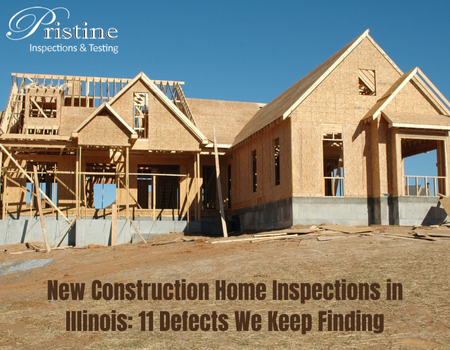When you purchase a new construction home in Illinois, it’s natural to assume everything will be perfect. After all, the house was just built, inspected by the city, and has never been lived in. But as home inspectors across Illinois can tell you, new construction doesn’t guarantee flawless workmanship. In fact, our inspectors regularly uncover issues that builders and municipal inspectors missed—some minor, others significant enough to lead to expensive repairs if left unaddressed.
If you’re building or buying a new home, here are 11 common defects we continue to find during inspections.
1. Foundation and Grading Problems
Poor grading around a new home is surprisingly common. We often find soil sloped toward the foundation instead of away from it, which can lead to water pooling and eventual basement leaks. Sometimes foundation cracks are visible even before the home is completed, especially around corners and window wells. These issues can worsen over time and are far easier to address before landscaping is complete.
2. Roofing Mistakes
We routinely find shingles that aren’t properly fastened, flashing that isn’t sealed, or vents installed incorrectly. Even a small gap in flashing can allow water intrusion, which may go unnoticed for years until it causes mold or structural damage. Roof repairs are far simpler (and cheaper) when caught early.
3. Missing or Insufficient Insulation
Brand-new homes should be energy efficient, but we frequently discover areas in attics, crawl spaces, and around rim joists where insulation is missing altogether or has been improperly installed. This can lead to higher energy bills and uncomfortable temperature swings.
4. Improperly Installed Windows and Doors
Poorly installed windows and doors are a consistent problem in new Illinois homes. We often see units that are out of square, not properly flashed, or lacking the necessary caulking. These issues allow drafts, water intrusion, and, eventually, rot around framing.
5. Electrical Issues
New construction isn’t immune to electrical defects. We often find outlets wired incorrectly, missing GFCI protection in bathrooms or kitchens, and breaker panels with mislabeled circuits. While these might seem minor, they can pose safety hazards if not corrected.
6. HVAC Problems
We regularly encounter ductwork that is disconnected or crushed, reducing airflow to certain rooms. Sometimes thermostats are wired improperly, or air returns are poorly placed, creating uneven heating and cooling. These problems affect comfort and energy efficiency and can put extra strain on the HVAC system.
7. Plumbing Defects
New homes frequently have plumbing issues such as loose supply line connections, poorly secured drain lines, or improper slope in waste lines. Even a small leak behind a wall can lead to water damage and mold if it goes unnoticed for long.
8. Siding and Exterior Finishes
Siding that isn’t nailed or sealed properly is a common find, as is missing flashing around decks, porches, and windows. These gaps can allow water to penetrate the exterior sheathing, leading to hidden rot.
9. Safety Railings
Deck and stair railings often fail to meet building codes in new homes. We frequently see guardrails that are too low, balusters spaced too far apart, or railings that feel loose because they aren’t anchored securely.
10. Attic Ventilation Problems
A properly ventilated attic prevents moisture buildup and extends the life of your roof. Unfortunately, we often find soffit vents that are blocked by insulation or missing altogether. Inadequate attic ventilation can lead to mold growth and ice damming in Illinois winters.
11. Cosmetic Cover-Ups
Finally, it’s not unusual to see cosmetic issues that hint at deeper problems. Poor drywall finishing, cracked tile grout, and mismatched flooring can all signal rushed workmanship. While these flaws may seem minor, they can also point to systemic quality control issues on the job site.
Why New-Construction Inspections Are Essential
Many buyers mistakenly believe the municipal inspection performed for the occupancy permit is enough. But city inspectors only check for code compliance and are often pressed for time. A private home inspection is more thorough and can uncover the types of defects that lead to major headaches down the road.
If you’re buying a new home in Illinois, schedule an independent inspection before your final walkthrough. A professional inspector will give you a detailed report you can present to the builder, allowing you to address problems before closing.
Even brand-new homes can have significant defects. Issues with grading, insulation, electrical wiring, and roofing are among the most common we encounter in Illinois, and catching them early can save you thousands in repairs. Don’t skip the inspection just because the house is new—investing in a thorough review by a qualified professional is one of the smartest moves you can make as a buyer.

